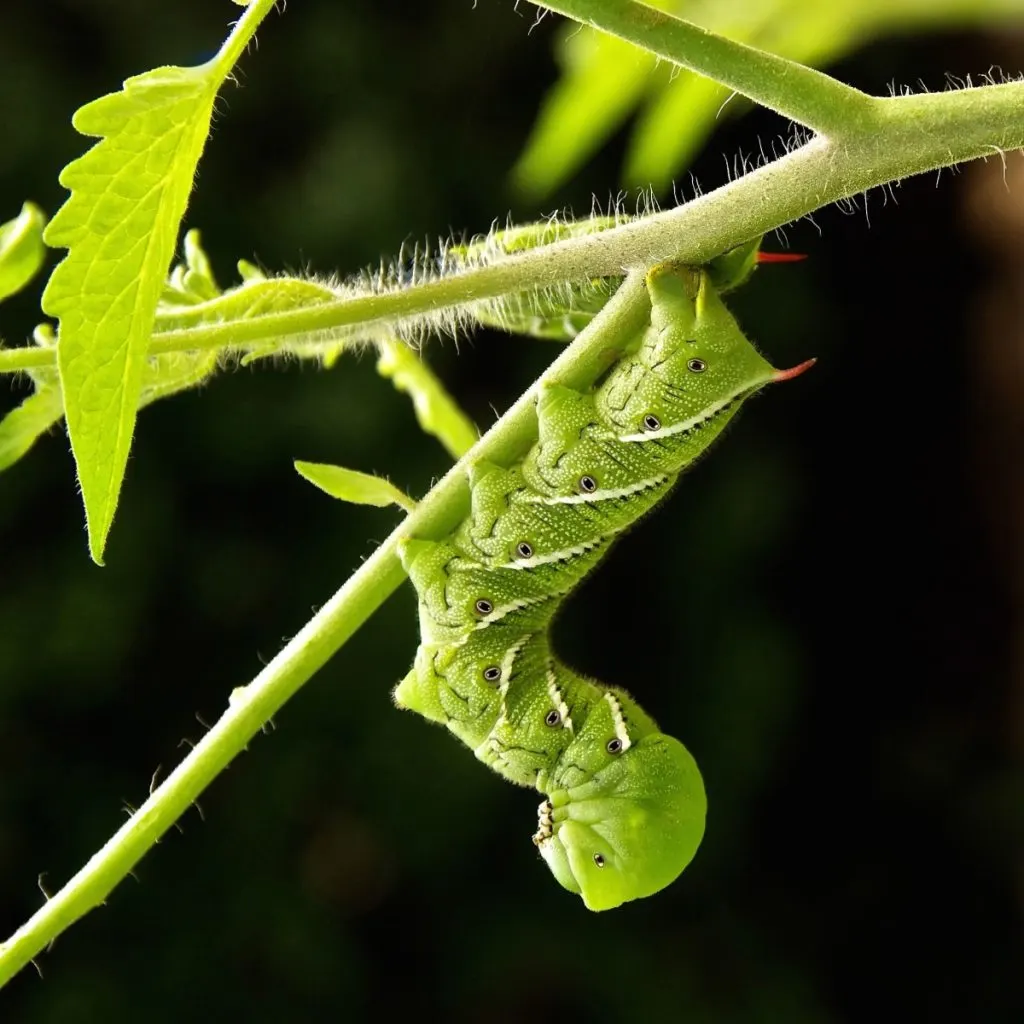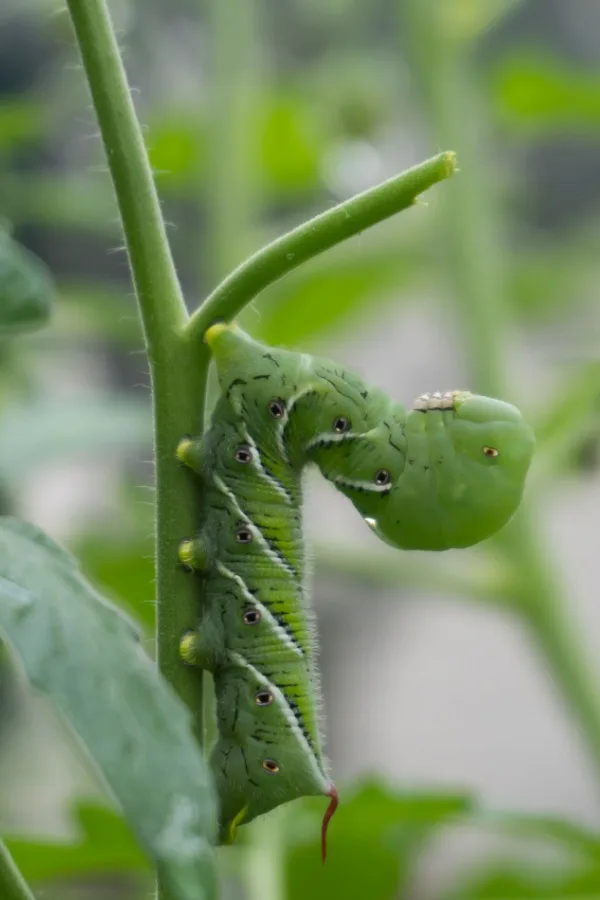Did you know that one of the easiest ways to find tomato hornworms on your tomato and pepper plants is with a simple blacklight flashlight? And can it ever help to keep your plants safe from the damage they bring!
Tomato hornworms are strange looking caterpillars that can measure up to 4 inches in length. What is most frustrating about them is that even though they are so big and cause massive damage to your tomato plants, they are often very tricky to find.
One of the biggest reasons for that is their natural camouflaging coloring. Tomato hornworms have light green skin that is almost identical to the coloring of tomato plants. This allows them to consume your tomato plants without easily being seen. By you – or predators.

And one thing is for sure with these pests – they can eat a lot! A single tomato hornworm is capable of devouring an entire tomato plant within just a few days. But it’s not just tomatoes that are on the menu – peppers, potatoes, tomatillos, and eggplants are also at risk of these pests.
Thankfully, even though the huge caterpillars might be difficult to spot during the daytime hours, their translucent body allows the pest to “glow” at night when a blacklight shines on them. The key, however, is to recognize the signs of the hornworms fast so you can quickly remove them as soon as possible.
Using A Blacklight To Find Tomato Hornworms
What Are Tomato Hornworms
To help recognize tomato hornworms and their damage, it’s a good idea to learn a little bit about their lifecycle first. Tomato hornworms start out as large brown moths. These moths spend most of their time pollinating flowers and laying their eggs in the springtime.
The eggs then hatch and the larvae immediately start feeding on the host plants – typically tomato plants. It only takes a hornworm a few days to grow from a half-inch-long larvae up to a massive four-inch-long caterpillar.
And the whole time they are growing, the hornworms are eating the leaves on your plants at an astonishingly rapid pace.

After just a few weeks, the mature caterpillar drops to the ground and burrows into the soil or plant debris and create a cocoon. The tomato hornworm will then overwinter there until it emerges as a moth again in the springtime. And the cycle continues.
Recognizing Their Damage – How To Find Tomato Hornworms With A Blacklight
While the tomato hornworm might be difficult to find, the damage they create certainly isn’t. Checking your garden often is the biggest key to managing tomato hornworms. Of course, that serves well to stay on top of other pests and disease issues as well.
Simply take a few minutes each day to walk your garden space. Look each plant over for any signs of damage or disease. If you allow too many days to pass between checks, that’s when the tomato hornworms or other issues start to get out of hand.
The hornworms usually begin their destruction starting at the top of the plant and work their way down. They consume all of the leaves and foliage until nothing is left but little stumps of stems.
Even once all of the foliage is gone, the hornworms don’t just stop there. Instead, they move on to the fruit, not caring whether the tomatoes are ripe or not. What’s left behind are nibbled tomatoes that aren’t even worth harvesting.
What To Do If You Spot Damage – How To Find Tomato Hornworms With A Blacklight
If you happen to notice stems or branches chewed down to little stubs, it’s time to look for the worms. It might take a bit for your eyes to spot the hungry caterpillars, but they will be there.

In addition to foliage damage, look for signs of hornworm droppings. Since the caterpillars eat so much, they also leave a lot behind as well. And while the hornworms might be hard to spot themselves, their droppings usually aren’t.
The droppings from young hornworms will look like tiny green or black dots on the top of leaves – almost like those of a fly. But as they mature, their droppings start to look like little pellets. Often, they can be piled up on the top of leaves.
If the droppings are green in color, take note because it means a tomato hornworm is within just a few inches. However, if the droppings are brown and dried, the hornworm is typically within a 1-foot diameter.
How To Use A Blacklight To Find Tomato Hornworms
If you are still having issues finding the hornworms despite these clues, it’s time to turn to one of the most amazing hornworm catchers of all – the blacklight. And does it ever make finding them easy!
All it takes to spot hornworms at night is an inexpensive blacklight that looks just like a small flashlight. And the wider the light’s beam, the more hornworms you will be able to spot in less time. Product Link: Vansky UV Flashlight Black Light
As you walk along your tomato plants, shine the flashlight beam from top to bottom of each plant. Be sure to cover the entire plant since the little pests can hide. If you prune your tomato plants regularly this task isn’t too difficult. If the plants are overgrown and full of foliage, it might take a bit more time. See, How To Prune Tomato Plants – And Why It’s So Important!
As soon as the blacklight’s beam lands on a tomato hornworm, it will glow against the dark foliage of the plant. It’s similar to how a white shirt will glow under a blacklight but a darker colored shirt won’t.
Once you spot a hornworm, simply remove it from the plant and drop it into a bucket of soapy water. By doing this every night for a few days, you should completely eliminate your tomato hornworm issue – and keep your plants safe in the process!
I Grow Tomatoes
Follow Our Facebook Page For Even More Great Tomato Growing Tips! I Grow Tomatoes Facebook Page
I Grow Tomatoes is a website created for those who love all things about tomatoes – from planting and growing – to cooking and canning! We publish two articles every week, 52 weeks a year. Sign up today to follow via email! This article may contain affiliate links.

